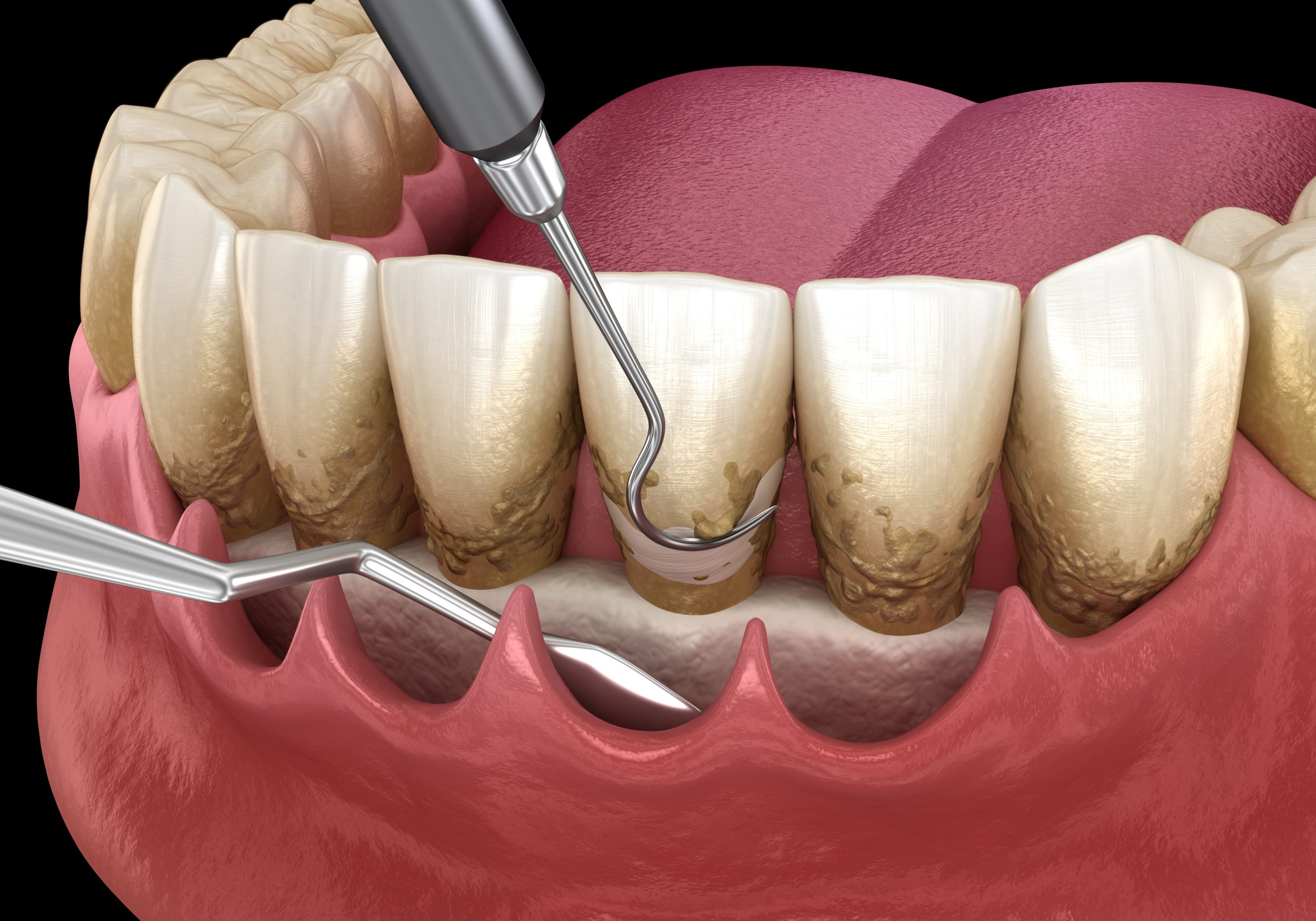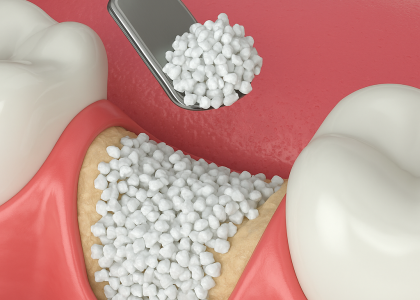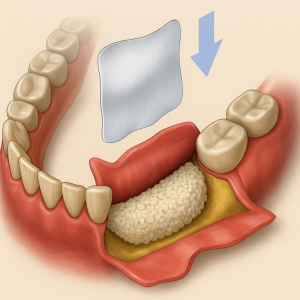Osseous Surgery (Flap Surgery) with regeneration, using bone and soft tissue grafts.
If deep pockets and inflammation persist after deep cleaning and antimicrobial treatments, osseous surgery may be necessary. During this procedure, the gums are gently lifted to allow thorough removal of tartar and bacteria from deep periodontal pockets. The bone may also be reshaped to eliminate defects and reduce pocket depth, making it easier for patients and dental professionals to maintain long-term oral hygiene.
In cases where gum disease has caused significant loss of bone or soft tissue, bone grafts or soft tissue grafts may be recommended. Grafting encourages the regeneration of lost structures, helping to stabilize the teeth or support future implant placement.
There are several types of grafting materials and membranes available today, each tailored to suit the specific clinical needs of the patient. Dr. Sperling will determine the most appropriate grafting technique based on your unique situation, ensuring optimal healing and long-term success.
Dental Extractions and Bone Grafting
When a tooth must be removed, preserving the surrounding bone structure is essential—especially if future dental implants are being considered. Dental extractions with bone grafting offer a proactive solution to maintain the integrity of the jawbone after tooth removal.
Why Bone Grafting After an Extraction?
After a tooth is extracted, the surrounding bone naturally begins to shrink, often leading to a loss in height and width of the ridge. This bone loss can impact facial appearance, compromise future implant placement, and limit restorative options.
To prevent this, a bone graft is placed immediately after the extraction into the empty socket. The graft acts as a scaffold, encouraging your body to regenerate natural bone over time and preserving the shape and density of the ridge.
What to Expect During the Procedure
- The extraction site is gently cleaned after tooth removal.
- Bone graft material—either synthetic, donor, or from the patient—is placed into the socket.
- A membrane may be used to protect the graft, and the area is closed with sutures.
- Over the following months, the graft material will integrate with your natural bone.
Benefits of Extraction with Bone Grafting
- Maintains jawbone volume and contour
- Creates a strong foundation for future dental implants
- Reduces the need for additional grafting later
- Enhances long-term esthetic and functional outcomes
Osseous Surgery

Bone Grafting

Dr. Sperling and Dr. Yu offer this procedure to help patients preserve their oral health and expand future treatment options after tooth loss. If you’re facing an extraction, ask about bone grafting to ensure the best possible outcome.
Sinus Lift Surgery

A sinus lift is a specialized surgical procedure that adds bone to the upper jaw in the area of the molars and premolars, just below the sinus cavities. This procedure is often necessary when there is insufficient bone height in the upper jaw to securely support a dental implant.
Why Is a Sinus Lift Needed?
When teeth are lost in the upper back region of the mouth, the jawbone in that area begins to shrink over time. Additionally, the maxillary sinus—a hollow cavity located above your upper jaw—can expand downward into the space once occupied by bone. This combination can leave too little bone to safely place a dental implant. A sinus lift rebuilds the lost bone height and lifts the sinus membrane to make room for new bone growth.
Common reasons for a sinus lift include:
-
Bone loss due to missing teeth or periodontal disease.
-
Naturally thin bone in the upper jaw.
-
Sinus expansion into the jaw area (pneumatization).
-
Preparation for one or more dental implants.
How the Procedure Works
-
A small opening is made in the upper jawbone near the sinus area.
-
The Sinus membrane is gently lifted upward.
-
Bone graft material is placed in the space between the jawbone and sinus cavity.
-
The area is sutured, and healing begins.
The bone graft can be your own bone, donor bone, or a synthetic material—chosen based on your needs and health.
Healing and Implant Placement
After a sinus lift, the bone will need 4 to 9 months to fully heal and integrate. Once this new bone becomes strong and stable, dental implants can be safely placed.
In some cases, if enough bone remains at the time of surgery, the implant may be placed at the same time as the sinus lift.
Benefits of Sinus Lift Surgery
-
Enables placement of dental implants in areas with bone loss
-
Restores jawbone height and structure
-
Improves long-term implant success
-
Maintains facial harmony and bite alignment
Ridge Augmentation
When a tooth is lost, the bone that once supported it can begin to shrink away. Over time, this natural bone loss may leave the jaw too thin or uneven to properly support a dental implant or restoration. Ridge augmentation is a specialized procedure that rebuilds the natural shape and volume of the jaw, restoring both function and appearance.
What Is Ridge Augmentation?
Ridge augmentation involves gently placing bone graft material into areas where the jawbone has been lost. This procedure restores the width and height of the ridge so that it looks and functions like natural bone. A protective membrane is often placed over the graft to guide healing and encourage new bone growth.
Why Is It Needed?
Untreated bone loss can make dental implants difficult or even impossible to place. In addition, ridge deficiencies can affect the look of your smile and even change facial contours. By rebuilding lost bone, ridge augmentation provides the solid foundation necessary for long-term implant success and a natural-looking result.

Materials We Use
At NovaPerio, we use only proven, safe, and biocompatible materials for ridge augmentation, including:
-
Bone grafts (from natural or synthetic sources) to restore volume.
-
Resorbable and Non-resorbable membranes to protect and guide bone healing.
-
Regenerative biomaterials to encourage your body’s natural ability to rebuild bone.
The Benefits of Ridge Augmentation
-
Creates a stable base for future dental implants.
-
Restores the natural shape and contour of the gums and jawline.
-
Prevents further bone deterioration.
-
Enhances both function and aesthetics of your smile.
Tel: (571) 234-1344 Mon – Fri 8 AM – 5 PM
email us at info@novaperio.com or fill the Contact Form
